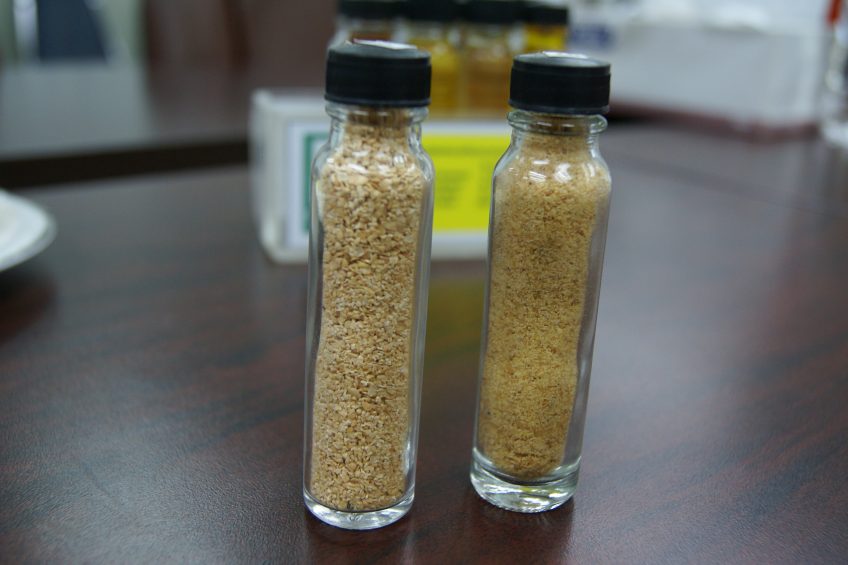How to get the most from soybean meal

Soybean meal contains anti-nutritional factors that cause problems such as lower performance and higher mortality. A select phytogenic feed additive and an effective mycotoxin deactivator can help producers get the most from soybean meal.
Soybean meal is a common ingredient in poultry diets worldwide due to ample supply and a favourable price level and it is the main protein source for birds in countries where meat and bone meal has been banned from animal diets, as in the EU since 2000.
Overly rapid transit
Particularly in the latter countries, transito rapido, or rapid feed passage, is a common metabolic problem in flocks related to anti-nutritional factors in diets that reduce nutrient availability. Table 1 lists the symptoms of a transito rapido outbreak. Soybeans, a legume, typically contain anti-nutritional factors including trypsin inhibitors, lectines and non-starch polysaccharides (NSPs).
Non-starch polysaccharides are usually present in cereals and plant-derived raw materials. They can vary a lot in terms of quantity in the raw material and in terms of the ratio between soluble and insoluble NSP. Their presence in the animal’s gut can vary the viscosity of the digest content modifying also the gut endogenous microbiota pattern. Anti-nutritional factors such as these can depress animal performance by decreasing nutrient digestibility and increasing local gut inflammation – a process that wastes nutrients and energy would otherwise go towards performance.
Phytogenics to the rescue
Phytogenic feed additives (PFAs), or botanicals, are a group of novel or non-antibiotic growth promoters (NGP’s) derived from herbs, spices and essential oils. A select phytogenic, in this particular case Digestarom from Biomin, through a complex mode of action in the gut, can help reduce the stress caused by anti-nutritional factors, thus improving the animal performance. In essence, the phytogenic significantly improved protein, amino acid and phosphorous digestibility and reduced gut inflammation. In addition, improved nutrient use means less ammonia in the litter and, consequently, fewer foot pad lesions and breast blisters.
Better feed conversion
The main benefit of a select phytogenic with a documented mode of action is better feed conversion. Phytogenics, by delivering feed efficiency gains, constitute one tool to replace antibiotic growth promoters (AGPs). Looking across 14 broiler trials performed in various countries worldwide and testing both AGPs and a select phytogenic feed additive at a variety of production stages, each PFA group performed similar on average in terms of feed conversion ratio (FCR) compared to the AGP group. The feed conversion ratio (FCR) showed an average improvement of 0.05 in the phytogenic supplemented group versus the AGP (control) group (Figure 1).
Figure 1 – Feed conversion ratio comparison, average of 14 trials.

Based on 2.5 kg end weight and 1.7 kg/kg FCR, every 0.01 improvement in FCR reduces total feed consumption by 25 g/bird. This indicates that birds need 0.5% less feed to reach the same weight, supporting profitability.
Mycotoxins
Mycotoxins constitute another anti-nutritional factor found in soybeans. Recent Biomin Mycotoxin Survey data shows that of 298 soybean meal samples analysed, 61% tested positive for deoxynivalenol, 49% contained zearalenone and 46% contained aflatoxins (Figure 2). These naturally-occurring fungal metabolites can introduce a host of negative effects in terms of health and performance in poultry.
Figure 2 – Mycotoxin contamination of 298 soybean meal samples analyzed January to July 2016.

Effects in birds
Mycotoxins’ general effects include impaired nutrient uptake, immune suppression and decreased performance. They can compromise several key functions of the GIT including decreased surface area available for nutrient absorption, modulation of nutrient transporters, and/or loss of barrier function. Several mycotoxins act as inhibitors of protein synthesis; many specifically target rapidly dividing and activated cells which are predominant in the gut epithelium. Others increase the persistence of intestinal pathogens and potentiate intestinal inflammation. The presence and relative toxic consequence of mycotoxins in animals can be kept under control using a proven mycotoxin deactivator.
Conclusion
Trypsin inhibitors, lectines, non-starch polysaccharides and mycotoxins are four anti-nutritional factors found in soybean meal that can negatively impact poultry. Producers looking to get the most from soybean meal would do well to consider a phytogenic feed additive with a documented mode of action, along with effective mycotoxin risk management. In this way, producers can capture the benefits of soybean meal as a protein source while avoiding several known pitfalls.













